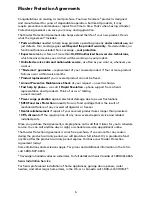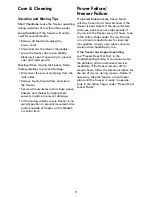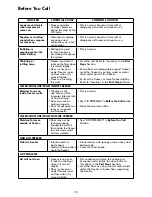
9
Optional Features
Defrost Drain
The defrost drain provides a method of
draining the water during defrosting and
cleaning. See “Defrosting” in Care and
Cleaning Section.
CAUTION
Damp objects stick to cold metal
surfaces. Do not touch inferior metal
surfaces with wet or damp hands.
Care & Cleaning
Between Defrostings
To avoid frequent defrosting, occasionally
use a plastic scraper to remove frost. Scrape
with a pulling motion. Never use a metal
instrument to remove frost.
CAUTION
Freezer must be unplugged (to avoid
electrical hazard) from power source
when defrosting unit.
Defrosting
WARNING
If leaving the freezer lid open while on
vacation, make certain that children cannot
get into the freezer and become entrapped.
WARNING
DO NOT use a sharp or metallic
instrument to remove frost from the
refrigerator interior, as damage to
refrigerant tubing may occur. Tubing
damage may allow flammable
refrigerant gas leakage, which can result
in personal injury.
Care & Cleaning
It is important to defrost and clean the
freezer when ¼ to ½ inch of frost has
accumulated. Frost may tend to accumulate
faster on the upper part of the freezer due
to warm, moist air entering the freezer when
the door is opened. Remove food and leave
the door open when defrosting the freezer.
If the frost is soft, remove it by using a
plastic scraper. If the frost is glazed and
hard, fill deep pans with hot water and
place them on the freezer bottom. Close the
freezer lid. Frost should soften in about 15
minutes. Repeat this procedure if necessary.
To Defrost Chest Models with Defrost Drain:
•
Place a shallow pan or the Divider/Drain
Pan (if equipped) beneath the drain outlet.
Pull out the outside drain plug (see figure
1). A ½ inch garden hose adapter can be
used to drain the freezer directly into a
floor drain (see figure 2). If your model is
not equipped with an adapter, one can be
purchased at most hardware stores.































